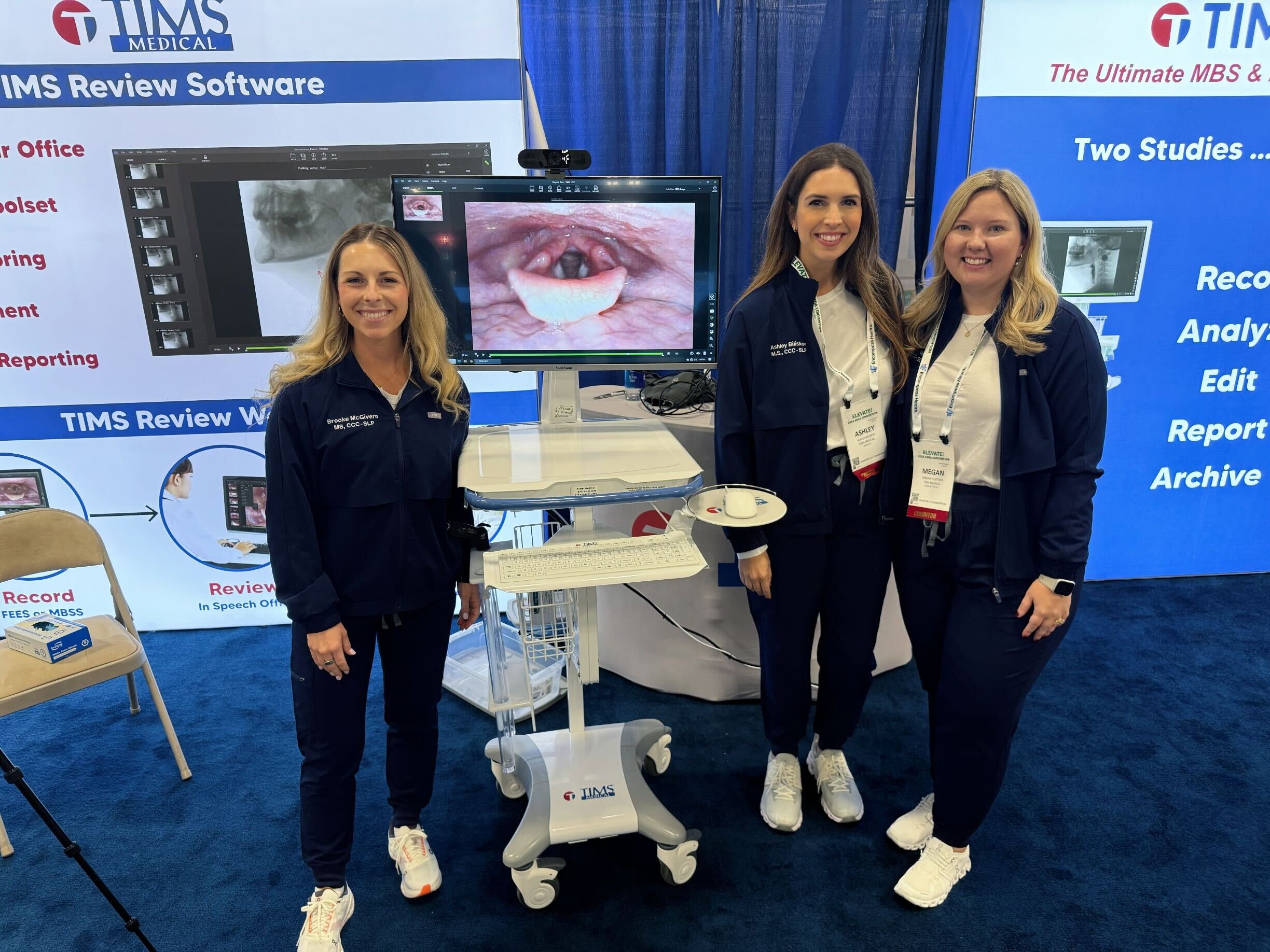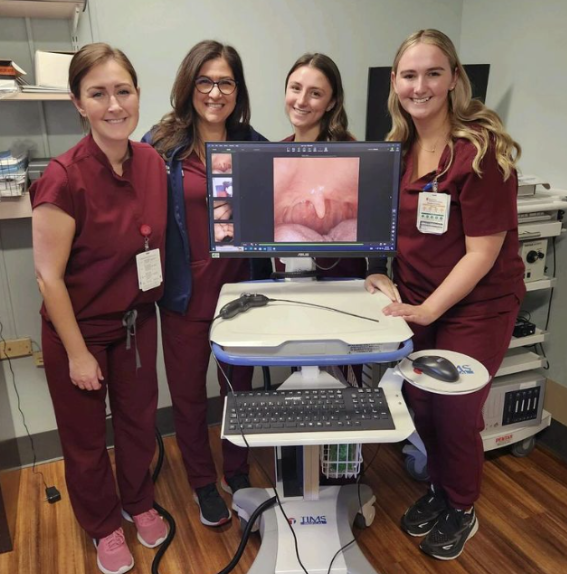TIMS Resources
FEES Competency and Program Development
Interested in developing a FEES program?
We can help.
There are many aspects to consider when developing a FEES program - TIMS is here to help you every step of the way. This page was created by our team to help make the process of FEES program development easier to understand. Explore the entire page or jump to the specific resources you need.
Steps for Developing a FEES Program
Equipment Considerations and Endoscopy Station Options
Steps for Developing a FEES Program
Determine Team Needs
2. Identify Key Advocates and Decision Makers
4. Meet with Key Advocates/Decision Makers
3. Write a Proposal
5. Team Training
6. Equipment Acquisition and Set Up
7. Advocacy & awareness within Interdisciplinary Team regarding the Benefits of FEES
8. Assess Progress-to-Date Including Success and Areas for Growth
9. Routine Updates with Advocates/ Decision Makers Regarding ROI
Want access to our in-depth step-by-step guide for FEES program development?
Equipment Considerations and Endoscopy Station Options
-
When selecting a scope, it is important to determine which aspects are most important to your team. Below are several components to review:
Image quality
Scope diameter
Toggle function
Light source location
Type of scope (i.e. USB, single-use, distal chip, fiberoptic).
Scope weight
Depth of field
Reprocessing requirements
*Note: List is not exhaustive
-
When a state does not have specific regulations or laws surrounding the use of FEES in practice, it is then up to the facility to create procedure protocols, safety guidelines, policies surrounding equipment, and competencies. The equipment manufacturer may have recommendations for some of those needs, so if you are or will be working with a representative from one of those companies, you may want to consider asking them for their input.
-
Software for endoscopy should include, at the basic level, simultaneous video and audio recording, frame-by-frame, review, slow motion and fast forward, the opportunity to share pertinent images/videos within the interdisciplinary team, as well as the ability to archive FEES to PACS/VNA.
Additionally, advances in software provide access to innovative tools which help improve efficiency and collaboration. TIMS MVP and TIMS Review provide such tools including each feature described above as well as telestrations, automatic whiteout detection, standardized analysis tools, semi-automated reporting, and more.
-
Customer support is a crucial factor when deciding which equipment to purchase. It is important to determine whether the vendor provides the following:
Opportunity to trial scope prior to purchase
Technical support
Scope loaner program
Scope reprocessing training
If these services are offered, how easy is it to connect with the team? What is the turn around time for loaner scopes if an issue occurs with your reusable scope?
The vendor you are working with should be able to answer each of these questions prior to purchase.
-
FEES software should allow video and audio recording, frame-by-frame review, slow motion, biofeedback, fast-forward, the opportunity for interdisciplinary team analysis, HIPAA-compliant recording/archiving, and patient access to the information (Groher & Crary, 2021; Langmore et al., 2022; Miller et al., 2020).
Equipment Considerations
There are many aspects to consider regarding equipment selection for endoscopy, including the type of scope, storage, reprocessing, transportation, and software. Let’s take a deeper dive into these topics.
Endoscopy Station Options
When determining the most optimal endoscopy setup for your team consider portability and the amount of space/storage needed for your selected endoscopy equipment. TIMS MVP is compatible with all endoscopy equipment. To date, more than 7,000 healthcare professionals worldwide have added TIMS to their diagnostic toolset. TIMS is in use with Olympus, Pentax, Atmos, PatCom, Optim, Ambu, Karl Storz, and JEDMED equipment. Check out example setups below.
Atmos + TIMS MVP
Pentax + TIMS MVP
Olympus + TIMS MVP
FEES Competency Guidelines
ASHA’s Recommendations: FEES Competency Considerations
Here’s a rundown of everything you need to know to add endoscopy to your clinical skillset. The ASHA team shares information about FEES training, competency, equipment, and resources.
Written by Stefanie LaManna, MS, CCC-SLP, CNT; ASHA Associate Director, Health Care Services in SLP
-
Some state licensing boards have specific regulations about endoscopy, including the number of passes needed, documentation and supervision requirements, and other considerations. ASHA’s state by state webpage is a good starting point, but it is always recommended to contact your state’s board, even if your state isn’t listed.
A good question to ask your licensing board would be “is there anything in our practice act that requires me to have a certain number of endoscope passes and physician oversight, and if so, what documentation is required?”
-
When a state does not have specific regulations or laws surrounding the use of FEES in practice, it is then up to the facility to create procedure protocols, safety guidelines, policies surrounding equipment, and competencies. The equipment manufacturer may have recommendations for some of those needs, so if you are or will be working with a representative from one of those companies, you may want to consider asking them for their input.
-
ASHA does not require additional certifications outside of the Certificate of Clinical Competence, so we don't set standards for other training or certification programs or for FEES competencies. The Code of Ethics does address competency as it relates to clinical activities (Principle I, Rule A), but it’s a self-identified level of competency, so it’s up to the individual clinician to make decisions about their skills and practice.
Different clinicians may require a different number of passes before they feel competent to perform the procedure independently. As with any new skill, there may be a lot of ground between meeting a minimum employer or state licensing standard and establishing competency at an independent level. As an example, completing an intensive course may help an SLP meet their state’s requirement for the minimal number of normal and disordered scope passes, but they may need many more months of collaborative learning to feel confident in the complexities of the assessment. It may be helpful to talk directly to some of the companies that offer FEES training about their or other health care facilities’ experiences for insight about clinicians’ average time to competency, lessons learned for clinicians new to FEES, and tips for translating newly learned skills into practice.
The Dysphagia Competency Verification Tool (DCVT) is another helpful tool developed by SIG 13: Swallowing and Swallowing Disorders and the American Board of Swallowing and Swallowing Disorders Joint Committee on Dysphagia Competencies, but it is not intended to replace formal instruction and instead can be used as a guide to develop your own competencies.
It’s usually a good idea to have written competencies to protect yourself from liability and because reviewers (like The Joint Commission) may want documentation of it; though ASHA doesn’t require written competencies for clinical skills, we’d be happy to support you and your facility in developing a competency plan that fits your needs.
Helpful Links:
-
There are many options for training and equipment. ASHA does not endorse any particular program or product. Click on each bullet point below to access resources to help guide you in deciding which course and manufacturer may be right for you and your facility:
o Tips for Choosing and Evaluating Continuing Education Courses
o What to Ask When Evaluating Any Procedure, Product, or Program
o Certificates, Certifications, and Competency: Investing in Your Future
You’ll want to discuss starting a FEES program with your administrators and ask questions like:
• What budget do we have for training courses and purchasing equipment? Are there grants we can apply for or is there support from the facility’s charitable foundation?
• What is our facility’s current process for cleaning equipment and what is the turnover time?
• How will we fit time into our schedules to support training, practice, and mentorship? Will we have access to per diem help or can we advocate for a new position to support this program development?
• Are there video storage or integration limitations with our current EMR and if so, how can we bypass that to support collaboration between SLPs and the medical team?
The equipment manufacturer will likely provide you with information to share with your administrators about equipment cost and EMR integration and storage, as well as requirements for processing and caring for endoscopic equipment.
-
Physician involvement may or may not be needed when developing a FEES program, depending on your state’s practice act and guidelines and if you have a competent SLP who is independent in passing a scope on a variety of patients and is capable of mentoring others. Though you may not need a physician in a mentorship role for passing a scope, you likely want to involve your hospital’s medical leadership in developing guidelines for the procedure and for emergency protocols.
You will also want to consider who may be reviewing the FEES recordings with input from your medical leadership. Instrumental swallowing evaluations are certainly within the SLP scope of practice, but SLPs do not differentially diagnose medical conditions. If you or one of your colleagues identifies an anatomical impairment during a FEES, you will want to have a clear pathway for referral within the interprofessional team so you can expedite care for your patient.
Helpful Link:
-
If you have more questions or want to take a deeper dive into all things FEES, here are a few other resources you might find helpful:
o Use of Endoscopy by Speech-Language Pathologists: Position Statement
o Frequently Asked Questions: Swallowing and Feeding (Dysphagia)
Expert Guidelines for Training and Competency for Adult FEES
Attend and complete an ASHA CE approved external FEES course or internal facility mentored training
Examination completion
Passing and handling the scope: minimum of 10 healthy volunteers
Passing the scope and performing a FEES exam: minimum of 15 patients
Indirect supervision: final step 5-10 FEES examinations
Expert Guidelines for Training and Competency for Pediatric FEES
Attend and complete an ASHA CE approved pediatric FEES Course
Knowledge Verification: Complete and pass the course examination
Identify an expert mentor or mentor team
Passing and handling the flexible endoscope - minimum of 10 healthy adult volunteers, observation of 10 pediatric FEES procedures, interpretation of a minimum of 10 previously recorded pediatric FEES examinations, assist the mentor in protocol determination and performance of FEES.
Passing and handling the flexible endoscope - minimum of 25 mentor-supervised pediatric FEES (both an SLP and ENT should be involved in this aspect of training).
Demonstration of competency - the Dysphagia Competency Verification Tool may be used
Indirect supervision
Billing and Patient Access to Information
Billing and Reimbursement
Procedure codes for FEES used by speech-language pathologists include:
Flexible endoscopic evaluation of swallowing (FEES): Code 92612
Flexible fiberoptic endoscopic evaluation of swallowing by cine or video recording (FEES); interpretation and report only: Code 92613
Treatment of swallowing function (SLP): Code 92526
Reimbursement Rates
Rates of reimbursement depend on a variety of aspects (ex. Mac Locality) however, you can learn more from the Centers for Medicare and Medicaid Services.
Reimbursement can be impacted by not archiving FEES. Ensure that you have the capability of recording, saving, and archiving your studies.
Patient Access to Information
HIPAA guarantees patients the right to obtain and review their medical records. Providing patients with easy access to their health records helps increase patient empowerment.
Access to health records helps patients:
Improve management of complex and chronic diseases
Increase adherence to recommended interventions
Puts patients in the "driver's seat" of their health
It is crucial to ensure that the software you choose allows you to archive FEES studies so that patients can access their records.
This page covers a lot, so we also offer this information in presentation format with references.


Our Team is Here to Support You
Undergoing FEES training and competency can seem daunting. Our team is here to support you in the process! We are happy to provide you with more information on resources for FEES courses, competency and training, and FEES equipment.
















